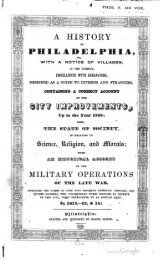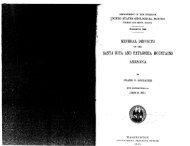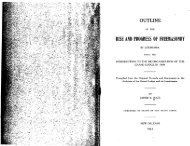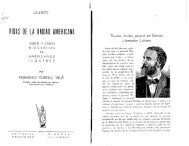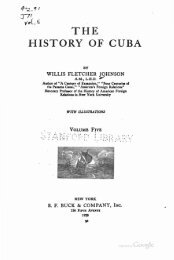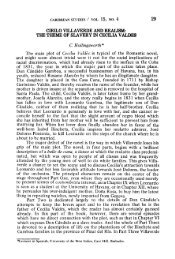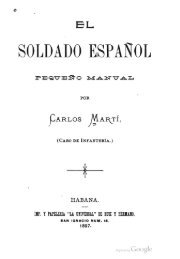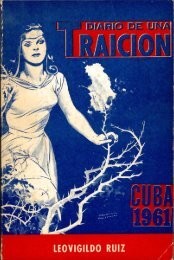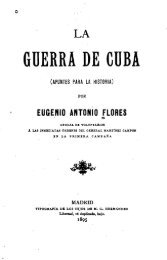Areas and Periods of Culture in the Greater Antilles
Areas and Periods of Culture in the Greater Antilles
Areas and Periods of Culture in the Greater Antilles
You also want an ePaper? Increase the reach of your titles
YUMPU automatically turns print PDFs into web optimized ePapers that Google loves.
252<br />
SOUTHWESTERN<br />
JOURNAL OF ANTHROPOLOGY<br />
PHASES AND STYLES<br />
The spatial <strong>and</strong> temporal units just outl<strong>in</strong>ed provide a scale upon which to<br />
lay out <strong>the</strong> archaeological rema<strong>in</strong>s <strong>of</strong> <strong>the</strong> <strong>Greater</strong> <strong>Antilles</strong>, as <strong>in</strong> Figure 2. The<br />
solid black l<strong>in</strong>e runn<strong>in</strong>g diagonally across <strong>the</strong> middle <strong>of</strong> this chart marks <strong>the</strong><br />
appearance <strong>of</strong> ceramics <strong>and</strong> agriculture; all <strong>the</strong> rema<strong>in</strong>s <strong>in</strong>dicated below this l<strong>in</strong>e<br />
lack pottery <strong>and</strong> agricultural utensils, while those above <strong>the</strong> l<strong>in</strong>e have both.<br />
The names below <strong>the</strong> solid black l<strong>in</strong>e refer to cultural phases, i.e. to complexes<br />
<strong>of</strong> type <strong>of</strong> artifacts which recur from site to site. The names above <strong>the</strong> l<strong>in</strong>e refer<br />
<strong>in</strong>stead to ceramic styles, i.e. to similarly recurr<strong>in</strong>g complexes <strong>of</strong> pottery traits.<br />
This difference <strong>of</strong> treatment is a concession to <strong>the</strong> nature <strong>of</strong> <strong>the</strong> data: <strong>in</strong> <strong>the</strong> sites<br />
represented below <strong>the</strong> l<strong>in</strong>e, implements are practically our sole source <strong>of</strong> <strong>in</strong>formation,<br />
while <strong>in</strong> <strong>the</strong> sites above <strong>the</strong> l<strong>in</strong>e, over n<strong>in</strong>ety-five percent <strong>of</strong> <strong>the</strong> artifacts<br />
found are ceramic. S<strong>in</strong>ce what is known <strong>of</strong> <strong>the</strong> burials, ceremonial structures, <strong>and</strong><br />
stone, bone, <strong>and</strong> shell artifacts associated with each style <strong>in</strong>dicates that <strong>the</strong>y<br />
varied <strong>in</strong> correlation with <strong>the</strong> pottery,15 it is thought that <strong>the</strong> shift from nonceramic<br />
phases to ceramic styles will not affect our conclusions.<br />
As is customary, we assume that all <strong>the</strong> phases below <strong>the</strong> solid black l<strong>in</strong>e are<br />
Ciboney, although this identification cannot be proven for lack <strong>of</strong> a detailed<br />
chronology <strong>of</strong> <strong>the</strong> non-ceramic phases <strong>and</strong> is rejected by some Cuban archaeologists.l6<br />
Similarly, we consider all <strong>the</strong> styles above <strong>the</strong> l<strong>in</strong>e to be Arawak. Here we<br />
are on firmer ground, s<strong>in</strong>ce stratigraphic studies <strong>in</strong> Puerto Rico <strong>in</strong>dicate a cont<strong>in</strong>uity<br />
<strong>of</strong> stylistic <strong>and</strong> cultural developments through <strong>Periods</strong> II, III, <strong>and</strong> IV.17<br />
It is not possible to correlate any <strong>of</strong> <strong>the</strong> rema<strong>in</strong>s so far discovered <strong>in</strong> <strong>the</strong><br />
<strong>Greater</strong> <strong>Antilles</strong> with <strong>the</strong> third ethnic group, <strong>the</strong> Carib. To judge from <strong>the</strong><br />
documentary evidence, Carib rema<strong>in</strong>s should eventually be found <strong>in</strong> <strong>the</strong> Virg<strong>in</strong><br />
Isl<strong>and</strong>s <strong>and</strong> on <strong>the</strong> islets <strong>of</strong>f <strong>the</strong> east coast <strong>of</strong> Puerto Rico, dat<strong>in</strong>g from Period<br />
IVb, at least. For <strong>the</strong> sake <strong>of</strong> completeness, <strong>the</strong>refore, we have added a dashed<br />
black l<strong>in</strong>e to <strong>the</strong> chart to mark <strong>of</strong>f <strong>the</strong> section which is potentially Carib, even<br />
though this will not figure <strong>in</strong> <strong>the</strong> present discussion <strong>of</strong> <strong>the</strong> archaeological rema<strong>in</strong>s.<br />
15 Cf., for example, Rouse (1948, pp. 510-517), where <strong>the</strong> Arawak material is presented<br />
<strong>in</strong> terms <strong>of</strong> cultural phases ra<strong>the</strong>r than ceramic styles.<br />
16 E.g., Pichardo Moya (1945), where it is assumed that <strong>the</strong> less advanced non-ceramic<br />
cultures, such as Guyabo Blanco, are pre-Ciboney.<br />
17 Rouse, MSa. Ra<strong>in</strong>ey (1940) concluded that <strong>the</strong>re was a break <strong>in</strong> <strong>the</strong> cultural sequence<br />
at <strong>the</strong> close <strong>of</strong> Period IIa, but this was subsequently filled by <strong>the</strong> discovery <strong>of</strong> rema<strong>in</strong>s dat<strong>in</strong>g<br />
from Period IIb.




